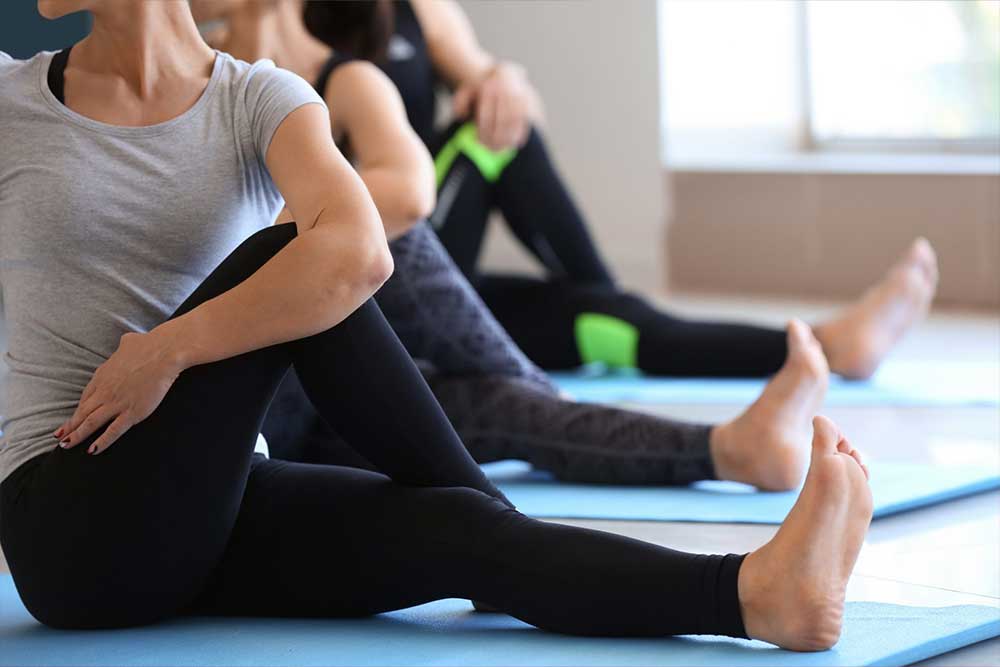Including pelvic floor exercises into your routine can help one of the downsides of menopause – unwanted bladder or bowel leaks and vaginal pain. Amanda Savage, a specialist pelvic health physiotherapist, explains how strengthening your pelvic muscles can help and why these muscles weaken during menopause.
Find what you need quickly
- Top five things that help pelvic floor symptoms
- What is the pelvic floor?
- Can menopause affect your pelvic floor?
- What happens if your pelvic floor weakens?
- Why does your pelvic floor weaken even if you‘ve never had children or a vaginal delivery?
- Do pelvic floor exercises work?
- Best pelvic floor exercises for menopause
- Need immediate help?
- How often do you need to do pelvic floor exercises?
- How long does it take for pelvic floor exercises to work?
- Can HRT improve pelvic floor symptoms?
- Do Kegel balls work for pelvic floor exercises?
- Should you do pelvic floor exercises if you’ve had a hysterectomy?
- Final word
Top five things that help pelvic floor symptoms
- Pelvic floor exercises three times a day for three months
- Bladder training
- Maintaining a healthy weight – this puts less pressure on your pelvic floor and internal organs
- Avoiding bladder irritants such as caffeine and alcohol
- Taking care not to drink too much water
What is the pelvic floor?
This wonderful group of muscles lines your pelvis from front to back and side to side. Most of the time it works as a posture muscle, supporting lightly and subconsciously in the background. It supports your internal organs, particularly the most low down ones – your bladder, bowel and uterus.
Some people describe it like a “hammock” but I like to think of it rather like a closed trap door. It’s an internal support platform that can be:
- Lightly shut – for posture
- More firmly shut – so you can resist the urge to wee or stop yourself leaking when you bounce on a trampoline
- Tightly shut – to counteract the pressure on your organs when you cough or sneeze, or pick up something heavy
These muscles also have the clever ability to selectively relax. They release to open a tiny hole, your urethra, so you can wee, and a little bigger, your anus, for poo. They can also relax a bit more when you have sex and flabbergastingly wide during childbirth. Of course, that’s when your pelvic floor muscles are working as they should do!
Can menopause affect your pelvic floor?
Hormone changes during menopause bring unique physical changes to your body. Your pelvic floor muscles depend on oestrogen to function well and for their elasticity. As your oestrogen levels decrease, so too do collagen levels. This means your muscles can be less effective at doing their supporting or relaxing jobs. Just like the rest of your muscles, this part of your body needs training. Read on to find out how to do this with pelvic floor exercises.
What happens if your pelvic floor weakens?
Some women experience issues for the first time during menopause and need to do pelvic floor exercises. For a few it can be severely debilitating and embarrassing, bringing on sudden leaks of wee or poo, or vaginal pain and discomfort.
Weak pelvic floor symptoms
For most women, pelvic floor issues gradually worsen during your menopause journey. Perhaps you have been stoically living with minor issues, from your childbearing years. Maybe you put up with:
- Occasionally leaking when coughing or sneezing
- Being unable to hold on until you reach the loo
- Increased sensitivity to caffeine or other triggers
- Getting up frequently at night to pee
- Feelings of vaginal heaviness, internal soreness and sensitivity
- Pain during sex
Sometimes these symptoms creep up on you so slowly it can be hard to remember when you moved from panty liners to absorbent pads, started planning your day around toilet stops, gave up hobbies because they were uncomfortable, or avoided sex.
As many as 1 in 3 women have pelvic floor symptoms but fewer than half seek help. A study found that it can take seven years for people to pluck up the courage to speak to their doctor.
If you develop any of these symptoms suddenly – especially if you are unable to control your bowels or bladder, have back pain, blood in your urine or any signs of a urinary tract infection – see your doctor urgently.
Why does your pelvic floor weaken even if you‘ve never had children or a vaginal delivery?
From puberty, all women depend on a nice steady supply of oestrogen for optimum muscle function and springy elasticity. As your body ages, even women who regularly exercise and have never had children or a vaginal delivery can be surprised to find they need to do specific pelvic floor exercises.
Do pelvic floor exercises work?
If you are managing some of the symptoms listed above, be reassured that your pelvic floor muscles are not shot or lost. Remember that with declining oestrogen levels you need to make a conscious effort to keep these muscles usefully strong and supple. This is where pelvic floor exercises come in!
A study of more than 2,000 women aged 40+ with bladder issues found that most reported an improved quality of life after doing pelvic floor muscle training.
Best pelvic floor exercises for menopause
Your pelvic floor muscles need to be deliberately exercised to build strength and tone to help keep the bladder and bowel tubes properly closed. This helps prevent leaks when pressure is exerted on your bladder and helps you ‘hold on’ until you are sitting on the toilet.
Preparing for pelvic floor exercises
- Find somewhere comfortable with enough space to relax
- You can do them sitting or laying down
- Focus on the area around your bladder and bowel openings
- Release any tension, especially if you have felt sore, heavy or vulnerable – you can’t work muscles that are tense
- If you have severe symptoms, talk to your doctor to make sure pelvic floor exercises will not make them worse
- Now you are ready to begin
Squeeze and lifts
Squeeze
- Tighten around your anus as if you are stopping bad wind or a poo
- As you tighten your anus also draw in the muscles at the opening of your vagina and urethra, as if you are trying to stop yourself having a wee mid-flow
Lift
- While you are holding everything tight – the anus, vagina and urethra area – pull up towards your belly button
- Hold this for as long as you can – up to a count of 10 as a maximum
- Release and relax
Hold and repetition baseline measurements
- Hold time. The number of seconds you can hold tight for is your “hold” score
- Repetitions number. The number of times you can squeeze and lift for your hold time, releasing and going again (up to a maximum of 10)
How should it feel to do squeeze and lifts
It should feel like your vagina, vulva and anus are clenching when you are squeezing and that you are pulling that squeeze up towards your belly button when lifting.
This technique can help keep you dry if you need to cough, sneeze, jump or pick up something heavy. They don’t have to last very long but they need to be strong!
In the past people were told not to tighten their buttocks or squeeze the anus. But now we know it is important to use the back part of the pelvic floor as well as the front. The back part creates the uplift action needed to support your bladder and uterus and prevent prolapse. Try not to use the buttocks too much but do let your anal sphincter contract and tighten with the vagina area too.”
Need immediate help?
“The Knack” is the magical art of drawing up your pelvic floor muscles just before you cough, sneeze, laugh or pick up something heavy. Research shows it works to stop leaks.
How often do you need to do pelvic floor exercises?
The gold standard to drive muscle development is to practice 10 sets of squeeze and lifts, three times a day for three months.
Ideally you should do a mixture of positions for the exercises – lying, sitting and standing.
How long does it take for pelvic floor exercises to work?
This isn’t about speed, it’s about accurate technique. It is important to get your pelvic floor exercises right. You may see improvements three to six months after doing this consistently several times a day.
Once you have the basics sorted, physiotherapists usually encourage women to combine pelvic floor exercises with improving your core strength as these two areas work well together to support your internal organs.
Can HRT improve pelvic floor symptoms?
Many pelvic floor symptoms can be grouped together as genitourinary symptoms of menopause (GSM). Some of these can be treated with:
- Topical oestrogen (cream or pessary) inserted into the vagina twice a week
- Whole body approaches with oestrogen gel, cream or patches
HRT does come with risks and is not suitable for everyone. Speak to your doctor about your treatment options and to rule out any other conditions that could cause your symptoms. If you are unable to take HRT, other medications may also help. Read more about the HRT debate.
Do Kegel balls work for pelvic floor exercises?
There are a number of gadgets out there that claim to help you with pelvic floor exercises and they range in price and complexity. All health professionals would suggest the right tool after a full assessment and examination and they are then widely available to buy directly for DIY home use on the internet.
At the lower price end of the range there are apps, such as Stella, to help you do your exercises accurately and remember to do them.
There are also vaginal weights, cones and balls that you put inside the vagina to add resistance as you exercise.
At the higher end (£100-£200), there are also small handheld devices that will send electrical impulses to your pelvic floor muscles to artificially exercise them. There are also a variety of vaginal probes that you can squeeze with your pelvic floor muscles and then see your results on a screen or even a phone app. Not unlike a computer game operated by your vaginal activity.
These devices are relatively new to the market and evidence is still emerging as to how useful they actually are. A few small studies have been published that seem to show little difference between these gadgets and standard pelvic floor therapy. However, if they encourage you to keep up with your exercises, it may be a useful addition to your treatment.
Should you do pelvic floor exercises if you’ve had a hysterectomy?
All gynaecology surgery disturbs the surrounding muscles and tissues. Usually, you are advised to make a concerted effort to improve your pelvic floor support before your operation, which is extra important if your hysterectomy was needed to correct a prolapse. Talk to your doctor about this before doing any exercises.
After surgery you can do daily pelvic floor exercises to build them back to their best selves, if this is what your doctor advises. This is exactly as you would for your leg muscles before and after a knee replacement, or your shoulder muscles after a rotator cuff repair.
Final word
I love working with women during the perimenopause or after menopause. Though at first it may seem a daunting time, women have so much to look forward to as they refocus their attention on their activity choices and what their body needs and wants.
Try not to see the perimenopause years as a loss or a threat. This is an era of opportunity, a chance to take stock of areas of gentle neglect, as well as notice your specific needs associated with the hormone changes of this life stage.
A few warning signs now lets you take steps to optimise your strength, fitness and flexibility and so preempt what may be coming up next as the body ages. Be pleased with what your body has managed in the decades to date and give it some love and attention for a healthy and confident journey ahead.
Try not to see the perimenopause years as a loss or a threat. This is an era of opportunity.”





